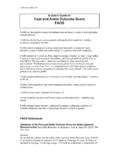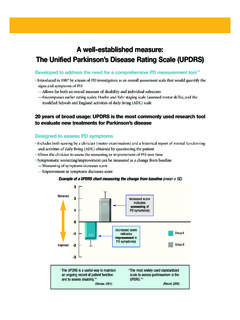Transcription of Mayo-Portland Adaptability Inventory-4
1 MPAI-4 3/31/03 Mayo-Portland Adaptability Inventory-4 Muriel D. Lezak, PhD, ABPP & James F. Malec, PhD, ABPP Name: _____ Clinic # _____ Date _____ Person reporting (circle one): Single Professional Professional Consensus Person with brain injury Significant other: _____ Below each item, circle the number that best describes the level at which the person being evaluated experiences problems. Mark the greatest level of problem that is appropriate. Problems that interfere rarely with daily or valued activities, that is, less than 5% of the time, should be considered not to interfere. Write comments about specific items at the end of the rating scale. For Items 1-20, please use the rating scale below. 0 None 1 Mild problem but does not interfere with activities; may use assistive device or medication 2 Mild problem; interferes with activities 5-24% of the time 3 Moderate problem; interferes with activities 25-75% of the time 4 Severe problem; interferes with activities more than 75% of the time Part A.
2 Abilities1. Mobility: Problems walking or moving; balance problems that interfere with moving about 0 1 2 3 4 2. Use of hands: Impaired strength or coordination in one or both hands 0 1 2 3 4 3. Vision: Problems seeing; double vision; eye, brain, or nerve injuries that interfere with seeing 0 1 2 3 4 4. *Audition: Problems hearing; ringing in the ears 0 1 2 3 4 5. Dizziness: Feeling unsteady, dizzy, light-headed 0 1 2 3 4 6. Motor speech: Abnormal clearness or rate of speech; stuttering 0 1 2 3 4 7A.
3 Verbal communication: Problems expressing or understanding language 0 1 2 3 4 7B. Nonverbal communication: Restricted or unusual gestures or facial expressions; talking too much or not enough; missing nonverbal cues from others 0 1 2 3 4 8. Attention/Concentration: Problems ignoring distractions, shifting attention, keeping more than one thing in mind at a time 0 1 2 3 4 9. Memory: Problems learning and recalling new information 0 1 2 3 4 10. Fund of Information: Problems remembering information learned in school or on the job; difficulty remembering information about self and family from years ago 0 1 2 3 4 11.
4 Novel problem-solving: Problems thinking up solutions or picking the best solution to new problems 0 1 2 3 4 12. Visuospatial abilities: Problems drawing, assembling things, route-finding, being visually aware on both the left and right sides 0 1 2 3 4 Part B. Adjustment13. Anxiety: Tense, nervous, fearful, phobias, nightmares, flashbacks of stressful events 0 1 2 3 4 14. Depression: Sad, blue, hopeless, poor appetite, poor sleep, worry, self-criticism 0 1 2 3 4 15. Irritability, anger, aggression: Verbal or physical expressions of anger 0 1 2 3 4 16. *Pain and headache: Verbal and nonverbal expressions of pain; activities limited by pain 0 1 2 3 4 17.
5 Fatigue: Feeling tired; lack of energy; tiring easily 0 1 2 3 4 18. Sensitivity to mild symptoms: Focusing on thinking, physical or emotional problems attributed to brain injury; rate only how concern or worry about these symptoms affects current functioning over and above the effects of the symptoms themselves 0 1 2 3 4 19. Inappropriate social interaction: Acting childish, silly, rude, behavior not fitting for time and place 0 1 2 3 4 20. Impaired self-awareness: Lack of recognition of personal limitations and disabilities and how they interfere with everyday activities and work or school 0 1 2 3 4 Use scale at the bottom of the page to rate item #21 21.
6 Family/significant relationships: Interactions with close others; describe stress within the family or those closest to the person with brain injury; family functioning means cooperating to accomplish those tasks that need to be done to keep the household running 0 Normal stress within family or other close network of relationships 1 Mild stress that does not interfere with family functioning 2 Mild stress that interferes with family functioning 5-24% of the time 3 Moderate stress that interferes with family functioning 25-75% of the time 4 Severe stress that interferes with family functioning more than 75% of the time MPAI-4 3/31/03 Part C. Participation22. Initiation: Problems getting started on activities without prompting 0 None 1 Mild problem but does not interfere with activities; may use assistive device or medication 2 Mild problem; interferes with activities 5-24% of the time 3 Moderate problem; interferes with activities 25-75% of the time 4 Severe problem; interferes with activities more than 75% of the time 23.
7 Social contact with friends, work associates, and other people who are not family, significant others, or professionals 0 Normal involvement with others 1 Mild difficulty in social situations but maintains normal involvement with others 2 Mildly limited involvement with others (75-95% of normal interaction for age) 3 Moderately limited involvement with others (25-74% of normal interaction for age) 4 No or rare involvement with others (less than 25% of normal interaction for age) 24. Leisure and recreational activities 0 Normal participation in leisure activities for age 1 Mild difficulty in these activities but maintains normal participation 2 Mildly limited participation (75-95% of normal participation for age) 3 Moderately limited participation (25-74% of normal participation for age) 4 No or rare participation (less than 25% of normal participation for age) 25. Self-care: Eating, dressing, bathing, hygiene 0 Independent completion of self-care activities 1 Mild difficulty, occasional omissions or mildly slowed completion of self-care; may use assistive device or require occasional prompting 2 Requires a little assistance or supervision from others (5-24% of the time) including frequent prompting 3 Requires moderate assistance or supervision from others (25-75% of the time) 4 Requires extensive assistance or supervision from others (more than 75% of the time) 26.
8 Residence: Responsibilities of independent living and homemaking (such as, meal preparation, home repairs and maintenance, personal health maintenance beyond basic hygiene including medication management) but not including managing money (see #29) 0 Independent; living without supervision or concern from others 1 Living without supervision but others have concerns about safety or managing responsibilities 2 Requires a little assistance or supervision from others ( 5-24% of the time) 3 Requires moderate assistance or supervision from others (25-75% of the time) 4 Requires extensive assistance or supervision from others (more than 75% of the time) 27. *Transportation 0 Independent in all modes of transportation including independent ability to operate a personal motor vehicle 1 Independent in all modes of transportation, but others have concerns about safety 2 Requires a little assistance or supervision from others (5-24% of the time); cannot drive 3 Requires moderate assistance or supervision from others (25-75% of the time); cannot drive 4 Requires extensive assistance or supervision from others (more than 75% of the time); cannot drive 28A.
9 *Paid Employment: Rate either item 28A or 28B to reflect the primary desired social role. Do not rate both. Rate 28A if the primary social role is paid employment. If another social role is primary, rate only 28B. For both 28A and 28B, support means special help from another person with responsibilities (such as, a job coach or shadow, tutor, helper) or reduced responsibilities. Modifications to the physical environment that facilitate employment are not considered as support. 0 Full-time (more than 30 hrs/wk) without support 1 Part-time (3 to 30 hrs/ wk) without support 2 Full-time or part-time with support 3 Sheltered work 4 Unemployed; employed less than 3 hours per week 28B. *Other employment: Involved in constructive, role-appropriate activity other than paid employment. Check only one to indicate primary desired social role: Childrearing/care-giving Homemaker, no childrearing or care-giving Student Volunteer Retired (Check retired only if over age 60; if unemployed, retired as disabled and under age 60, indicate Unemployed for item 28A.)
10 0 Full-time (more than 30 hrs/wk) without support; full-time course load for students 1 Part-time (3 to 30 hrs/ wk) without support 2 Full-time or part-time with support 3 Activities in a supervised environment other than a sheltered workshop 4 Inactive; involved in role-appropriate activities less than 3 hours per week 29. Managing money and finances: Shopping, keeping a check book or other bank account, managing personal income and investments; if independent with small purchases but not able to manage larger personal finances or investments, rate 3 or 4. 0 Independent, manages small purchases and personal finances without supervision or concern from others 1 Manages money independently but others have concerns about larger financial decisions 2 Requires a little help or supervision (5-24% of the time) with large finances; independent with small purchases 3 Requires moderate help or supervision (25-75% of the time) with large finances; some help with small purchases 4 Requires extensive help or supervision (more than 75% of the time) with large finances; frequent help with small purchases MPAI-4 3/31/03 Part D: Pre-existing and associated conditions.












